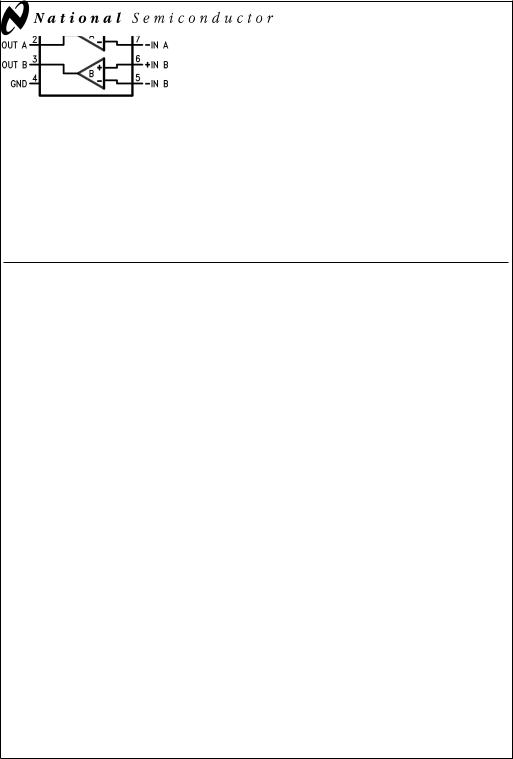NSC DS9637ACN, DS9637ACMX, DS9637ACMWC, DS9637ACMDC, DS9637ACM Datasheet
...
May 1998
DS9637A
Dual Differential Line Receiver
General Description
The DS9637A is a Schottky dual differential line receiver which has been specifically designed to satisfy the requirements of EIA Standards RS-422 and RS-423. In addition, the DS9637A satisfies the requirements of MIL-STD 188-114 and is compatible with the International Standard CCITT recommendations. The DS9637A is suitable for use as a line receiver in digital data systems, using either single ended or differential, unipolar or bipolar transmission. It requires a single 5V power supply and has Schottky TTL compatible outputs. The DS9637A has an operational input common mode range of ±7V either differentially or to ground.
Features
nDual channel
nSingle 5V supply
nSatisfies EIA standards RS-422 and RS423
nBuilt-in ±35 mV hysteresis
nHigh input common mode voltage range
nHigh input impedance
nTTL compatible outputs
nSchottky technology
nExtended temperature range
Connection Diagram
8±Lead DIP and SO-8 Package
DS009621-1
Top View
Order Number DS9637ACM or DS9637ACN See NS Package Number M08A or N08E
For Complete Military Product Specifications, refer to the appropriate SMD or MDS.
Order Number DS9637AMJ/883
See NS Package Number J08A
Receiver Line Differential Dual DS9637A
© 1998 National Semiconductor Corporation |
DS009621 |
www.national.com |

Absolute Maximum Ratings (Note 2)
If Military/Aerospace specified devices are required, please contact the National Semiconductor Sales Office/ Distributors for availability and specifications.
Storage Temperature Range |
|
Ceramic DIP |
−65ÊC to + 175ÊC |
Molded DIP |
−65ÊC to + 150ÊC |
Lead Temperature |
|
Ceramic DIP |
|
(Soldering, 30 seconds) |
300ÊC |
Molded DIP and SO Package |
|
(Soldering, 10 seconds) |
265ÊC |
Maximum Power Dissipation (Note 1) at 25ÊC |
|
Cavity Package |
1300 mW |
Molded Package |
930 mW |
SO Package |
810 mW |
VCC Lead Potential to Ground |
−0.5V to 7.0V |
Input Potential to Ground |
±15V |
Differential Input Voltage |
±15V |
Output Potential to Ground |
−0.5V to +5.5V |
Output Sink Current |
50 mA |
Recommended Operating
Conditions
DS9637AM |
Min |
Max |
Units |
Supply Voltage (VCC) |
4.5 |
5.5 |
V |
Operating Temperature (TA) |
−55 |
+125 |
ÊC |
DS9637AC |
|
|
|
Supply Voltage (VCC) |
4.75 |
5.25 |
V |
Operating Temperature (TA) |
0 |
+70 |
ÊC |
Note 1: Derate cavity package 8.7 mW/ÊC above 25ÊC; derate molded DIP package 7.5 mW/ÊC above 25ÊC; derate SO package 6.5 mW/ÊC above 25ÊC.
Electrical Characteristics (Notes 3, 4)
Over recommended operating temperature and supply voltage ranges, unless otherwise specified
Symbol |
Parameter |
|
Conditions |
Min |
Typ |
Max |
Units |
|
|
|
|
|
|
|
|
VTH |
Differential Input |
−7.0V |
≤ VCM ≤ +7.0V |
−0.2 |
|
+0.2 |
V |
|
Threshold Voltage (Note 6) |
|
|
|
|
|
|
|
|
|
|
|
|
|
|
VTH(R) |
Differential Input |
−7.0V |
≤ VCM ≤ +7.0V |
−0.4 |
|
+0.4 |
V |
|
Threshold Voltage (Note 7) |
|
|
|
|
|
|
|
|
|
|
|
|
|
|
II |
Input Current |
VI = 10V, 0V ≤ VCC ≤ +5.5V |
|
1.1 |
3.25 |
mA |
|
|
(Note 8) |
VI = −10V, 0V ≤ VCC ≤ +5.5V |
|
−1.6 |
−3.25 |
|
|
VOL |
Output Voltage LOW |
IOL = 20 mA, VCC = Min |
|
0.35 |
0.5 |
V |
|
VOH |
Output Voltage HIGH |
IOH = −1.0 mA, V CC = Min |
2.5 |
3.5 |
|
V |
|
IOS |
Output Short Circuit |
VO = 0V, VCC = Max |
−40 |
−75 |
−100 |
mA |
|
|
Current (Note 5) |
|
|
|
|
|
|
|
|
|
|
|
|
|
|
ICC |
Supply Current |
VCC = Max, VI+ = 0.5V, |
|
35 |
50 |
mA |
|
|
|
VI− = GND |
|
|
|
|
|
VHYST |
Input Hysteresis |
VCM = ±7.0V (See Curves) |
|
70 |
|
mV |
|
Note 2: ªAbsolute Maximum Ratingsº are those values beyond which the safety of the device cannot be guaranteed. They are not meant to imply that the devices should be operated at these limits. The tables of ªElectrical Characteristicsº provide conditions for actual device operation.
Note 3: Unless otherwise specified Min/Max limits apply across the −55ÊC to +125ÊC temperature range for DS9637AM and across the 0ÊC to +70ÊC range for the DS9637ASC. All typicals are given for VCC = 5V and TA = 25ÊC.
Note 4: All currents into the device pins are positive; all currents out of the device pins are negative. All voltages are referenced to ground unless otherwise specified.
Note 5: Only one output at a time should be shorted.
Note 6: VDIFF (Differential Input Voltage) = (VI+) − (V I−). V CM (Common Mode Input Voltage) = VI+ or VI−.
Note 7: 500Ω ±1% in series with inputs.
Note 8: The input not under test is tied to ground.
Switching Characteristics
VCC = 5.0V, TA = 25ÊC
Symbol |
Parameter |
Conditions |
Min |
Typ |
Max |
Units |
|
|
|
|
|
|
|
tPLH |
Propagation Delay Time |
See AC Test Circuit |
|
15 |
25 |
ns |
|
Low to High |
|
|
|
|
|
tPHL |
Propagation Delay Time |
See AC Test Circuit |
|
13 |
25 |
ns |
|
High to Low |
|
|
|
|
|
|
|
|
|
|
|
|
www.national.com |
2 |
